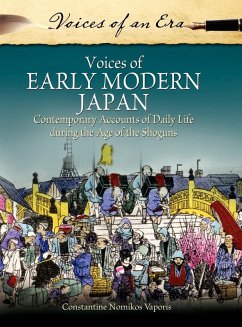Constantine Vaporis
Voices of Early Modern Japan
Contemporary Accounts of Daily Life During the Age of the Shoguns
Constantine Vaporis
Voices of Early Modern Japan
Contemporary Accounts of Daily Life During the Age of the Shoguns
- Gebundenes Buch
- Merkliste
- Auf die Merkliste
- Bewerten Bewerten
- Teilen
- Produkt teilen
- Produkterinnerung
- Produkterinnerung
Based on fresh translations of historical documents, this volume offers a revealing look at Japan during the time of the Tokugawa shoguns from 1600-1868, focusing on the day-to-day lives of both the rich and powerful and ordinary citizens. Voices of Early Modern Japan: Contemporary Accounts of Daily Life during the Age of the Shoguns spans an extraordinary period of Japanese history, ranging from the unification of the warring states under Tokugawa Ieyasu in the early 17th century to the overthrow of the shogunate just prior to the mid-19th century opening of Japan by the West. Through close…mehr
Andere Kunden interessierten sich auch für
![Emerging Lesbian Voices from Japan Emerging Lesbian Voices from Japan]() Sharon ChalmersEmerging Lesbian Voices from Japan76,99 €
Sharon ChalmersEmerging Lesbian Voices from Japan76,99 €![Voices from the Shifting Russo-Japanese Border Voices from the Shifting Russo-Japanese Border]() Voices from the Shifting Russo-Japanese Border73,99 €
Voices from the Shifting Russo-Japanese Border73,99 €![Voices from the Shifting Russo-Japanese Border Voices from the Shifting Russo-Japanese Border]() Voices from the Shifting Russo-Japanese Border228,99 €
Voices from the Shifting Russo-Japanese Border228,99 €![Emerging Lesbian Voices from Japan Emerging Lesbian Voices from Japan]() Sharon ChalmersEmerging Lesbian Voices from Japan270,99 €
Sharon ChalmersEmerging Lesbian Voices from Japan270,99 €![Voices of Ancient Greece and Rome Voices of Ancient Greece and Rome]() David MatzVoices of Ancient Greece and Rome122,99 €
David MatzVoices of Ancient Greece and Rome122,99 €![Competing Voices from the Russian Revolution Competing Voices from the Russian Revolution]() Competing Voices from the Russian Revolution86,99 €
Competing Voices from the Russian Revolution86,99 €![Voices of Civil War America Voices of Civil War America]() Voices of Civil War America122,99 €
Voices of Civil War America122,99 €-
-
-
Based on fresh translations of historical documents, this volume offers a revealing look at Japan during the time of the Tokugawa shoguns from 1600-1868, focusing on the day-to-day lives of both the rich and powerful and ordinary citizens. Voices of Early Modern Japan: Contemporary Accounts of Daily Life during the Age of the Shoguns spans an extraordinary period of Japanese history, ranging from the unification of the warring states under Tokugawa Ieyasu in the early 17th century to the overthrow of the shogunate just prior to the mid-19th century opening of Japan by the West. Through close examinations of sources from a time known as "The Great Peace," this fascinating volume offers fresh insights into the Tokugawa era-its political institutions, rigid class hierarchy, artistic and material culture, religious life, and more. Sources come from all levels of Japanese society, everything from government documents and household records to personal correspondence and diaries, all carefully translated and examined in light of the latest scholarship.
Hinweis: Dieser Artikel kann nur an eine deutsche Lieferadresse ausgeliefert werden.
Hinweis: Dieser Artikel kann nur an eine deutsche Lieferadresse ausgeliefert werden.
Produktdetails
- Produktdetails
- Verlag: Greenwood
- Seitenzahl: 332
- Erscheinungstermin: 6. Januar 2012
- Englisch
- Abmessung: 286mm x 221mm x 22mm
- Gewicht: 1097g
- ISBN-13: 9780313392009
- ISBN-10: 0313392005
- Artikelnr.: 33762238
- Herstellerkennzeichnung
- Libri GmbH
- Europaallee 1
- 36244 Bad Hersfeld
- gpsr@libri.de
- Verlag: Greenwood
- Seitenzahl: 332
- Erscheinungstermin: 6. Januar 2012
- Englisch
- Abmessung: 286mm x 221mm x 22mm
- Gewicht: 1097g
- ISBN-13: 9780313392009
- ISBN-10: 0313392005
- Artikelnr.: 33762238
- Herstellerkennzeichnung
- Libri GmbH
- Europaallee 1
- 36244 Bad Hersfeld
- gpsr@libri.de
Constantine Nomikos Vaporis,, PhD, is professor of history at University of Maryland, Baltimore County. He is author of several books, including Voices of Early Modern Japan.
Preface Acknowledgments Introduction: The Shogun's Japan Evaluating and
Interpreting Primary Documents Timeline of Japanese History from the
Mid-Sixteenth Century through the Tokugawa Period, 1543-1868 Documents of
the Shogun's Japan The Domestic Sphere 1. Getting Married: "Agreement
Regarding a Dowry" (1815) 2. Obtaining a Divorce: An Appeal for Assistance
(1850) and Letters of Divorce (1857, undated) 3. The Consequences of
Adultery: "The Eavesdropper Whose Ears Were Burned" (1686) 4. A Woman's
Place: Onna Daigaku (The Greater Learning for Women, 1716) and Tadano
Makuzu's Hitori Kangae (Solitary Thoughts, 1818) Material Life 5.
Regulating Fashion and Consumption: Ihara Saikaku's The Japanese Family
Storehouse (Nippon eitai gura, 1688); List of Prohibitions Concerning
Clothing for Edo Townsmen (1719) 6. Samurai Dress and Grooming Standards:
Prohibitions of 1615 and 1645 7. Lunisolar Calendar: Calendar for Seventh
Year of Kaei (1854): Samurai in Armor 8. Japanese Foodways and Diet: The
Accounts of Joao Rodrigues (1620-1621), Yamakawa Kikue (1943), and Edo
hanjôki (1832-1836) 9. The Communal Bath: Shikitei Sanba's "The Women's
Bath" (Ukiyoburo, 1810) 10. The Japanese Home: Carl Peter Thunberg's
Travels in Europe, Asia and Africa Made during the Years 1770 and 1779
(1791) The Political Sphere 11. A Foreigner's View of the Battle of Osaka:
Richard Cocks's Account of the Fall of Osaka Castle (1615) 12. Forging
Political Order: "Laws for the Military Houses" (1615, 1635) 13. The
Emperor and the Kyoto Aristocracy: "Regulations for the Imperial Palace and
the Court Nobility" (1615) 14. Weapons Control in Japanese Society:
Toyotomi Hideyoshi's "Sword Hunt" (1588) and "A Local Edo Ordinance
Regarding Swords" (1648) 15. Self-Governance in Villages: Goningumi
(Five-Household Group) Laws (1640) 16. Regulating Townspeople in Two
Cities: City Code from Kanazawa (1642) and Notice Board in Edo (1711)
Foreign Relations 17. Regulating Foreign Relations: The "Closed Country
Edicts" (sakoku rei, 1635, 1639) 18. Tokugawa Japan and Choson Korea: "The
Diary of Shin Yu-han" (1719) 19. Leaving a Window Open to the Western
World: Letter from a Nagasaki Official to the Dutch Governor General (1642)
20. A Dutch Audience with the Shogun: Englebert Kaempfer's The History of
Japan (1692) 21. Sizing Up the Foreign Threat: Aizawa Seishisai's Shinron
(New Theses, 1825) Social and Economic Life 22. The Social Estates: Yamaga
Sokô on "The Way of the Samurai" (shidô) 23. Trying to Get by on a Fixed
Income: The Economic Problems Facing the Samurai, as Seen in a Letter from
Tani Tannai to Saitaniya Hachirôbei Naomasu (1751) and a Statement from
Three Village Leaders to a Tokugawa Bannerman (1856) 24. The Samurai and
Death: An Account of Junshi from Francois Caron's A True Description of the
Mighty Kingdoms of Japan and Siam (1636) 25. Private Vengeance among
Samurai: "A Letter from a Daimyo's Official in Echigo Province to an
Official of the Tokugawa Shogunate" and "A Letter of Authorization" (1828)
26. Rules of Merchant Houses: "The Testament of Shimai Sôshitsu" (1610) and
"The Code of the Okaya House" (1836) 27. Dealing with Deviant Behavior: "A
Letter of Apology" (1866) 28. Loans among the Peasantry: "Rice Borrowed"
(1702) 29. Unrest in the Countryside: A Song in Memory of a Protest (1786)
and Petition to the Lord of Sendai from the Peasants of the Sanhei (1853)
30. Outcastes in Tokugawa Society: A Report from the Head of All Eta and
Hinin (undated) and an Inquiry by the Edo City Magistrates to the Tokugawa
Council of State Regarding the Forfeiture of the Property of an Eta Who
Assumed the Status of a Commoner (1799) Recreational Life 31. Advice to
Travelers in the Edo Period: Ryokô Yôjinshû (Precautions for Travelers,
1810) 32. Documentation for Travel: "Sekisho Transit Permit" (1706) and "A
Passport" (1782) 33. Children and Their Amusements: The Journal of Francis
Hall (1859) 34. The Tea Ceremony: Chikamatsu Shigenori's Stories from a
Tearoom Window (1804) 35. Archery and the Martial Arts: Hinatsu Shirôzaemon
Shigetaka's Honchô Bugei Shôden (A Short Tale of the Martial Arts in Our
Country, 1714) 36. Courtesans and the Sex Trade: Ihara Saikaku's The Life
of an Amorous Man (Koshoku ichidai otoko, 1682) and Buyô Ishi's An Account
of Worldly Affairs (Seji kenmonroku, 1816) 37. A Hero for the Masses: The
Kabuki Play Sukeroku: Flower of Edo (1713) Religion and Morality 38.
Preaching to the People: A Sermon by Hosoi Heishû (1783) 39. Anti-Christian
Propaganda: Kirishitan monogatari (1639) 40. Controlling the Populace:
Registers of Religious Affiliation (1804) 41. Religious Views of the
Japanese: Sir Rutherford Alcock's The Capital of the Tycoon (1863) 42. The
Teachings of Zen Buddhism: Suzuki Shôsan's Roankyô (Donkey-Saddle Bridge,
1648) and Hakuin Ekaku's Sokkô-roku Kaien-fusetsu (Talks Given Introductory
to Zen Lectures on the Records of Sokkô, 1740) Appendix 1: Biographical
Sketches of Important Individuals Mentioned in Text Appendix 2: Glossary of
Terms Mentioned in Text Bibliography Index
Interpreting Primary Documents Timeline of Japanese History from the
Mid-Sixteenth Century through the Tokugawa Period, 1543-1868 Documents of
the Shogun's Japan The Domestic Sphere 1. Getting Married: "Agreement
Regarding a Dowry" (1815) 2. Obtaining a Divorce: An Appeal for Assistance
(1850) and Letters of Divorce (1857, undated) 3. The Consequences of
Adultery: "The Eavesdropper Whose Ears Were Burned" (1686) 4. A Woman's
Place: Onna Daigaku (The Greater Learning for Women, 1716) and Tadano
Makuzu's Hitori Kangae (Solitary Thoughts, 1818) Material Life 5.
Regulating Fashion and Consumption: Ihara Saikaku's The Japanese Family
Storehouse (Nippon eitai gura, 1688); List of Prohibitions Concerning
Clothing for Edo Townsmen (1719) 6. Samurai Dress and Grooming Standards:
Prohibitions of 1615 and 1645 7. Lunisolar Calendar: Calendar for Seventh
Year of Kaei (1854): Samurai in Armor 8. Japanese Foodways and Diet: The
Accounts of Joao Rodrigues (1620-1621), Yamakawa Kikue (1943), and Edo
hanjôki (1832-1836) 9. The Communal Bath: Shikitei Sanba's "The Women's
Bath" (Ukiyoburo, 1810) 10. The Japanese Home: Carl Peter Thunberg's
Travels in Europe, Asia and Africa Made during the Years 1770 and 1779
(1791) The Political Sphere 11. A Foreigner's View of the Battle of Osaka:
Richard Cocks's Account of the Fall of Osaka Castle (1615) 12. Forging
Political Order: "Laws for the Military Houses" (1615, 1635) 13. The
Emperor and the Kyoto Aristocracy: "Regulations for the Imperial Palace and
the Court Nobility" (1615) 14. Weapons Control in Japanese Society:
Toyotomi Hideyoshi's "Sword Hunt" (1588) and "A Local Edo Ordinance
Regarding Swords" (1648) 15. Self-Governance in Villages: Goningumi
(Five-Household Group) Laws (1640) 16. Regulating Townspeople in Two
Cities: City Code from Kanazawa (1642) and Notice Board in Edo (1711)
Foreign Relations 17. Regulating Foreign Relations: The "Closed Country
Edicts" (sakoku rei, 1635, 1639) 18. Tokugawa Japan and Choson Korea: "The
Diary of Shin Yu-han" (1719) 19. Leaving a Window Open to the Western
World: Letter from a Nagasaki Official to the Dutch Governor General (1642)
20. A Dutch Audience with the Shogun: Englebert Kaempfer's The History of
Japan (1692) 21. Sizing Up the Foreign Threat: Aizawa Seishisai's Shinron
(New Theses, 1825) Social and Economic Life 22. The Social Estates: Yamaga
Sokô on "The Way of the Samurai" (shidô) 23. Trying to Get by on a Fixed
Income: The Economic Problems Facing the Samurai, as Seen in a Letter from
Tani Tannai to Saitaniya Hachirôbei Naomasu (1751) and a Statement from
Three Village Leaders to a Tokugawa Bannerman (1856) 24. The Samurai and
Death: An Account of Junshi from Francois Caron's A True Description of the
Mighty Kingdoms of Japan and Siam (1636) 25. Private Vengeance among
Samurai: "A Letter from a Daimyo's Official in Echigo Province to an
Official of the Tokugawa Shogunate" and "A Letter of Authorization" (1828)
26. Rules of Merchant Houses: "The Testament of Shimai Sôshitsu" (1610) and
"The Code of the Okaya House" (1836) 27. Dealing with Deviant Behavior: "A
Letter of Apology" (1866) 28. Loans among the Peasantry: "Rice Borrowed"
(1702) 29. Unrest in the Countryside: A Song in Memory of a Protest (1786)
and Petition to the Lord of Sendai from the Peasants of the Sanhei (1853)
30. Outcastes in Tokugawa Society: A Report from the Head of All Eta and
Hinin (undated) and an Inquiry by the Edo City Magistrates to the Tokugawa
Council of State Regarding the Forfeiture of the Property of an Eta Who
Assumed the Status of a Commoner (1799) Recreational Life 31. Advice to
Travelers in the Edo Period: Ryokô Yôjinshû (Precautions for Travelers,
1810) 32. Documentation for Travel: "Sekisho Transit Permit" (1706) and "A
Passport" (1782) 33. Children and Their Amusements: The Journal of Francis
Hall (1859) 34. The Tea Ceremony: Chikamatsu Shigenori's Stories from a
Tearoom Window (1804) 35. Archery and the Martial Arts: Hinatsu Shirôzaemon
Shigetaka's Honchô Bugei Shôden (A Short Tale of the Martial Arts in Our
Country, 1714) 36. Courtesans and the Sex Trade: Ihara Saikaku's The Life
of an Amorous Man (Koshoku ichidai otoko, 1682) and Buyô Ishi's An Account
of Worldly Affairs (Seji kenmonroku, 1816) 37. A Hero for the Masses: The
Kabuki Play Sukeroku: Flower of Edo (1713) Religion and Morality 38.
Preaching to the People: A Sermon by Hosoi Heishû (1783) 39. Anti-Christian
Propaganda: Kirishitan monogatari (1639) 40. Controlling the Populace:
Registers of Religious Affiliation (1804) 41. Religious Views of the
Japanese: Sir Rutherford Alcock's The Capital of the Tycoon (1863) 42. The
Teachings of Zen Buddhism: Suzuki Shôsan's Roankyô (Donkey-Saddle Bridge,
1648) and Hakuin Ekaku's Sokkô-roku Kaien-fusetsu (Talks Given Introductory
to Zen Lectures on the Records of Sokkô, 1740) Appendix 1: Biographical
Sketches of Important Individuals Mentioned in Text Appendix 2: Glossary of
Terms Mentioned in Text Bibliography Index
Preface Acknowledgments Introduction: The Shogun's Japan Evaluating and
Interpreting Primary Documents Timeline of Japanese History from the
Mid-Sixteenth Century through the Tokugawa Period, 1543-1868 Documents of
the Shogun's Japan The Domestic Sphere 1. Getting Married: "Agreement
Regarding a Dowry" (1815) 2. Obtaining a Divorce: An Appeal for Assistance
(1850) and Letters of Divorce (1857, undated) 3. The Consequences of
Adultery: "The Eavesdropper Whose Ears Were Burned" (1686) 4. A Woman's
Place: Onna Daigaku (The Greater Learning for Women, 1716) and Tadano
Makuzu's Hitori Kangae (Solitary Thoughts, 1818) Material Life 5.
Regulating Fashion and Consumption: Ihara Saikaku's The Japanese Family
Storehouse (Nippon eitai gura, 1688); List of Prohibitions Concerning
Clothing for Edo Townsmen (1719) 6. Samurai Dress and Grooming Standards:
Prohibitions of 1615 and 1645 7. Lunisolar Calendar: Calendar for Seventh
Year of Kaei (1854): Samurai in Armor 8. Japanese Foodways and Diet: The
Accounts of Joao Rodrigues (1620-1621), Yamakawa Kikue (1943), and Edo
hanjôki (1832-1836) 9. The Communal Bath: Shikitei Sanba's "The Women's
Bath" (Ukiyoburo, 1810) 10. The Japanese Home: Carl Peter Thunberg's
Travels in Europe, Asia and Africa Made during the Years 1770 and 1779
(1791) The Political Sphere 11. A Foreigner's View of the Battle of Osaka:
Richard Cocks's Account of the Fall of Osaka Castle (1615) 12. Forging
Political Order: "Laws for the Military Houses" (1615, 1635) 13. The
Emperor and the Kyoto Aristocracy: "Regulations for the Imperial Palace and
the Court Nobility" (1615) 14. Weapons Control in Japanese Society:
Toyotomi Hideyoshi's "Sword Hunt" (1588) and "A Local Edo Ordinance
Regarding Swords" (1648) 15. Self-Governance in Villages: Goningumi
(Five-Household Group) Laws (1640) 16. Regulating Townspeople in Two
Cities: City Code from Kanazawa (1642) and Notice Board in Edo (1711)
Foreign Relations 17. Regulating Foreign Relations: The "Closed Country
Edicts" (sakoku rei, 1635, 1639) 18. Tokugawa Japan and Choson Korea: "The
Diary of Shin Yu-han" (1719) 19. Leaving a Window Open to the Western
World: Letter from a Nagasaki Official to the Dutch Governor General (1642)
20. A Dutch Audience with the Shogun: Englebert Kaempfer's The History of
Japan (1692) 21. Sizing Up the Foreign Threat: Aizawa Seishisai's Shinron
(New Theses, 1825) Social and Economic Life 22. The Social Estates: Yamaga
Sokô on "The Way of the Samurai" (shidô) 23. Trying to Get by on a Fixed
Income: The Economic Problems Facing the Samurai, as Seen in a Letter from
Tani Tannai to Saitaniya Hachirôbei Naomasu (1751) and a Statement from
Three Village Leaders to a Tokugawa Bannerman (1856) 24. The Samurai and
Death: An Account of Junshi from Francois Caron's A True Description of the
Mighty Kingdoms of Japan and Siam (1636) 25. Private Vengeance among
Samurai: "A Letter from a Daimyo's Official in Echigo Province to an
Official of the Tokugawa Shogunate" and "A Letter of Authorization" (1828)
26. Rules of Merchant Houses: "The Testament of Shimai Sôshitsu" (1610) and
"The Code of the Okaya House" (1836) 27. Dealing with Deviant Behavior: "A
Letter of Apology" (1866) 28. Loans among the Peasantry: "Rice Borrowed"
(1702) 29. Unrest in the Countryside: A Song in Memory of a Protest (1786)
and Petition to the Lord of Sendai from the Peasants of the Sanhei (1853)
30. Outcastes in Tokugawa Society: A Report from the Head of All Eta and
Hinin (undated) and an Inquiry by the Edo City Magistrates to the Tokugawa
Council of State Regarding the Forfeiture of the Property of an Eta Who
Assumed the Status of a Commoner (1799) Recreational Life 31. Advice to
Travelers in the Edo Period: Ryokô Yôjinshû (Precautions for Travelers,
1810) 32. Documentation for Travel: "Sekisho Transit Permit" (1706) and "A
Passport" (1782) 33. Children and Their Amusements: The Journal of Francis
Hall (1859) 34. The Tea Ceremony: Chikamatsu Shigenori's Stories from a
Tearoom Window (1804) 35. Archery and the Martial Arts: Hinatsu Shirôzaemon
Shigetaka's Honchô Bugei Shôden (A Short Tale of the Martial Arts in Our
Country, 1714) 36. Courtesans and the Sex Trade: Ihara Saikaku's The Life
of an Amorous Man (Koshoku ichidai otoko, 1682) and Buyô Ishi's An Account
of Worldly Affairs (Seji kenmonroku, 1816) 37. A Hero for the Masses: The
Kabuki Play Sukeroku: Flower of Edo (1713) Religion and Morality 38.
Preaching to the People: A Sermon by Hosoi Heishû (1783) 39. Anti-Christian
Propaganda: Kirishitan monogatari (1639) 40. Controlling the Populace:
Registers of Religious Affiliation (1804) 41. Religious Views of the
Japanese: Sir Rutherford Alcock's The Capital of the Tycoon (1863) 42. The
Teachings of Zen Buddhism: Suzuki Shôsan's Roankyô (Donkey-Saddle Bridge,
1648) and Hakuin Ekaku's Sokkô-roku Kaien-fusetsu (Talks Given Introductory
to Zen Lectures on the Records of Sokkô, 1740) Appendix 1: Biographical
Sketches of Important Individuals Mentioned in Text Appendix 2: Glossary of
Terms Mentioned in Text Bibliography Index
Interpreting Primary Documents Timeline of Japanese History from the
Mid-Sixteenth Century through the Tokugawa Period, 1543-1868 Documents of
the Shogun's Japan The Domestic Sphere 1. Getting Married: "Agreement
Regarding a Dowry" (1815) 2. Obtaining a Divorce: An Appeal for Assistance
(1850) and Letters of Divorce (1857, undated) 3. The Consequences of
Adultery: "The Eavesdropper Whose Ears Were Burned" (1686) 4. A Woman's
Place: Onna Daigaku (The Greater Learning for Women, 1716) and Tadano
Makuzu's Hitori Kangae (Solitary Thoughts, 1818) Material Life 5.
Regulating Fashion and Consumption: Ihara Saikaku's The Japanese Family
Storehouse (Nippon eitai gura, 1688); List of Prohibitions Concerning
Clothing for Edo Townsmen (1719) 6. Samurai Dress and Grooming Standards:
Prohibitions of 1615 and 1645 7. Lunisolar Calendar: Calendar for Seventh
Year of Kaei (1854): Samurai in Armor 8. Japanese Foodways and Diet: The
Accounts of Joao Rodrigues (1620-1621), Yamakawa Kikue (1943), and Edo
hanjôki (1832-1836) 9. The Communal Bath: Shikitei Sanba's "The Women's
Bath" (Ukiyoburo, 1810) 10. The Japanese Home: Carl Peter Thunberg's
Travels in Europe, Asia and Africa Made during the Years 1770 and 1779
(1791) The Political Sphere 11. A Foreigner's View of the Battle of Osaka:
Richard Cocks's Account of the Fall of Osaka Castle (1615) 12. Forging
Political Order: "Laws for the Military Houses" (1615, 1635) 13. The
Emperor and the Kyoto Aristocracy: "Regulations for the Imperial Palace and
the Court Nobility" (1615) 14. Weapons Control in Japanese Society:
Toyotomi Hideyoshi's "Sword Hunt" (1588) and "A Local Edo Ordinance
Regarding Swords" (1648) 15. Self-Governance in Villages: Goningumi
(Five-Household Group) Laws (1640) 16. Regulating Townspeople in Two
Cities: City Code from Kanazawa (1642) and Notice Board in Edo (1711)
Foreign Relations 17. Regulating Foreign Relations: The "Closed Country
Edicts" (sakoku rei, 1635, 1639) 18. Tokugawa Japan and Choson Korea: "The
Diary of Shin Yu-han" (1719) 19. Leaving a Window Open to the Western
World: Letter from a Nagasaki Official to the Dutch Governor General (1642)
20. A Dutch Audience with the Shogun: Englebert Kaempfer's The History of
Japan (1692) 21. Sizing Up the Foreign Threat: Aizawa Seishisai's Shinron
(New Theses, 1825) Social and Economic Life 22. The Social Estates: Yamaga
Sokô on "The Way of the Samurai" (shidô) 23. Trying to Get by on a Fixed
Income: The Economic Problems Facing the Samurai, as Seen in a Letter from
Tani Tannai to Saitaniya Hachirôbei Naomasu (1751) and a Statement from
Three Village Leaders to a Tokugawa Bannerman (1856) 24. The Samurai and
Death: An Account of Junshi from Francois Caron's A True Description of the
Mighty Kingdoms of Japan and Siam (1636) 25. Private Vengeance among
Samurai: "A Letter from a Daimyo's Official in Echigo Province to an
Official of the Tokugawa Shogunate" and "A Letter of Authorization" (1828)
26. Rules of Merchant Houses: "The Testament of Shimai Sôshitsu" (1610) and
"The Code of the Okaya House" (1836) 27. Dealing with Deviant Behavior: "A
Letter of Apology" (1866) 28. Loans among the Peasantry: "Rice Borrowed"
(1702) 29. Unrest in the Countryside: A Song in Memory of a Protest (1786)
and Petition to the Lord of Sendai from the Peasants of the Sanhei (1853)
30. Outcastes in Tokugawa Society: A Report from the Head of All Eta and
Hinin (undated) and an Inquiry by the Edo City Magistrates to the Tokugawa
Council of State Regarding the Forfeiture of the Property of an Eta Who
Assumed the Status of a Commoner (1799) Recreational Life 31. Advice to
Travelers in the Edo Period: Ryokô Yôjinshû (Precautions for Travelers,
1810) 32. Documentation for Travel: "Sekisho Transit Permit" (1706) and "A
Passport" (1782) 33. Children and Their Amusements: The Journal of Francis
Hall (1859) 34. The Tea Ceremony: Chikamatsu Shigenori's Stories from a
Tearoom Window (1804) 35. Archery and the Martial Arts: Hinatsu Shirôzaemon
Shigetaka's Honchô Bugei Shôden (A Short Tale of the Martial Arts in Our
Country, 1714) 36. Courtesans and the Sex Trade: Ihara Saikaku's The Life
of an Amorous Man (Koshoku ichidai otoko, 1682) and Buyô Ishi's An Account
of Worldly Affairs (Seji kenmonroku, 1816) 37. A Hero for the Masses: The
Kabuki Play Sukeroku: Flower of Edo (1713) Religion and Morality 38.
Preaching to the People: A Sermon by Hosoi Heishû (1783) 39. Anti-Christian
Propaganda: Kirishitan monogatari (1639) 40. Controlling the Populace:
Registers of Religious Affiliation (1804) 41. Religious Views of the
Japanese: Sir Rutherford Alcock's The Capital of the Tycoon (1863) 42. The
Teachings of Zen Buddhism: Suzuki Shôsan's Roankyô (Donkey-Saddle Bridge,
1648) and Hakuin Ekaku's Sokkô-roku Kaien-fusetsu (Talks Given Introductory
to Zen Lectures on the Records of Sokkô, 1740) Appendix 1: Biographical
Sketches of Important Individuals Mentioned in Text Appendix 2: Glossary of
Terms Mentioned in Text Bibliography Index








